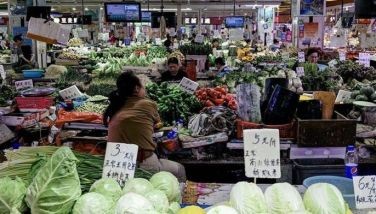Filipino yogurt, Japanese technology
September 13, 2004 | 12:00am
When Japan-based Chichiyasu Dairy Co. research and development manager Kotaro Yodoe visited the National Dairy Authority office last May 26, he was offered a bottle of pineapple-flavored yogurt to drink. "Very good," he told his host, NDA administrator Salvacion Bulatao,
Pineapple is one of four fruits used by the Sta. Maria Dairy Farmers Multi-Purpose Cooperative in Bulacan to flavor its drinking yogurt.
Two months later, NDA got the same reaction from Chichiyasu chief executive officer Sonkyo Nomura.
"We are thinking of putting up a joint venture plant here, either with the Philippine government or with a dairy farmers cooperative. This will be our first production venture in the Asian market. We are also thinking of either entering into purchase agreements or outright contract growing arrangements with dairy farmers and fruit growers to ensure the stable supply of raw carabao milk and fresh fruits for the plant," said Nomura, who visited dairy farms such as Sta. Maria Dairy and the Philippine Carabao Center.
"We have been importing fruit purees from Philippine companies that we blend with milk for our yogurt production. We know from experience that Philippine fruits are the best and juiciest in the world. We also prefer carabao’s milk over imported powdered milk for yogurt production in the Philippines," said Nomura.
Chichiyasu is currently the third largest dairy company in the 2 trillion-yen Japan dairy industry and the biggest one controlled by Japanese stakeholders.
"We are less concerned about being the biggest player in the dairy market than with customizing our yogurt and other fermented product lines to the Asian taste," said Nomura.
In the Japanese dairy industry, yogurt, ice cream, cheese, and milk account for only 15% of total sales. Chichiyasu, for example, also produces fruit jellies, pudding, and fruit juices.
he company was started in 1886 by Tamotsu Nomura as a family milk business. In 1917, it expanded into the production of yogurt.
"Today, our milk and yogurt are equated with standard-setting and premium quality dairy products. In all of our 117 years in business, we have never encountered health-threatening problems such as contamination," Nomura said.
The company has also been a pioneer in marketing yogurt. It was Chichiyasu, for example, which first sold yogurt in cups instead of in traditional glass jars. The company also successfully segmented the market, which now supports 50 to 60 flavors of yogurt.
A segment that Chichiyasu continues to be strong in is the healthy and active consumer market. Teltou, a low-sugar yogurt, has been a best-seller since its introduction in 1983.
An aromatic fruit series called alo4e yogurt is marketed for its good skin benefits. There is also reuteri yogurt, which is popular in Japan, the United States, and Europe because it helps combat S mutans.
Despite its technological advancements through the years, however, the company is most proud of its long and proud service to the people of Japan, which included, among others, the Emperor Meiji when he temporarily moved his headquarters to Hiroshima and the victims of the atom bomb.
Pineapple is one of four fruits used by the Sta. Maria Dairy Farmers Multi-Purpose Cooperative in Bulacan to flavor its drinking yogurt.
Two months later, NDA got the same reaction from Chichiyasu chief executive officer Sonkyo Nomura.
"We are thinking of putting up a joint venture plant here, either with the Philippine government or with a dairy farmers cooperative. This will be our first production venture in the Asian market. We are also thinking of either entering into purchase agreements or outright contract growing arrangements with dairy farmers and fruit growers to ensure the stable supply of raw carabao milk and fresh fruits for the plant," said Nomura, who visited dairy farms such as Sta. Maria Dairy and the Philippine Carabao Center.
"We have been importing fruit purees from Philippine companies that we blend with milk for our yogurt production. We know from experience that Philippine fruits are the best and juiciest in the world. We also prefer carabao’s milk over imported powdered milk for yogurt production in the Philippines," said Nomura.
Chichiyasu is currently the third largest dairy company in the 2 trillion-yen Japan dairy industry and the biggest one controlled by Japanese stakeholders.
"We are less concerned about being the biggest player in the dairy market than with customizing our yogurt and other fermented product lines to the Asian taste," said Nomura.
In the Japanese dairy industry, yogurt, ice cream, cheese, and milk account for only 15% of total sales. Chichiyasu, for example, also produces fruit jellies, pudding, and fruit juices.
"Today, our milk and yogurt are equated with standard-setting and premium quality dairy products. In all of our 117 years in business, we have never encountered health-threatening problems such as contamination," Nomura said.
The company has also been a pioneer in marketing yogurt. It was Chichiyasu, for example, which first sold yogurt in cups instead of in traditional glass jars. The company also successfully segmented the market, which now supports 50 to 60 flavors of yogurt.
A segment that Chichiyasu continues to be strong in is the healthy and active consumer market. Teltou, a low-sugar yogurt, has been a best-seller since its introduction in 1983.
An aromatic fruit series called alo4e yogurt is marketed for its good skin benefits. There is also reuteri yogurt, which is popular in Japan, the United States, and Europe because it helps combat S mutans.
Despite its technological advancements through the years, however, the company is most proud of its long and proud service to the people of Japan, which included, among others, the Emperor Meiji when he temporarily moved his headquarters to Hiroshima and the victims of the atom bomb.
BrandSpace Articles
<
>
- Latest
Latest
Latest
January 2, 2025 - 2:00pm
January 2, 2025 - 2:00pm
December 17, 2024 - 12:00am
December 17, 2024 - 12:00am
December 16, 2024 - 10:00am
December 16, 2024 - 10:00am
December 5, 2024 - 12:00am
December 5, 2024 - 12:00am
Recommended




























